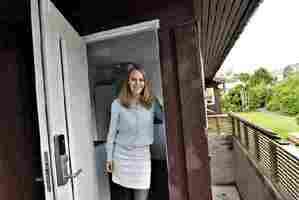Whereby co-founder’s 6 tips for nailing remote work
Did you know Ingrid Ødegaard is speaking at TNW2020 this year? Check out their session on ‘How to compete with tech giants’ here .

“Decoupling location from work can fundamentally change the way we build our societies.”
Ingrid Ødegaard’s statement is firm, and comes naturally when she talks. Not like a futurist’s vision, but rather based on hands-on experience from the way the tech startup Whereby has worked since long before Covid-19.
“We give people the ability to take the job with them, a possibility that has enabled big life changes for some. When people move back to their small home towns, it also affects those communities and helps them maintain a sustainable base of taxpayers,” she says.
Whereby, the video collaboration company from Norway, has seen a 30 times increase in its services in the last few months. Co-founder and Chief Product and Technology Officer Ødegaard reveals that it wasn’t a global pandemic or the fact that a video conferencing tool is the core of their business that made them become a “work from anywhere” team.
“In 2013, we were co-located, but we were forced to think differently when one of our colleagues wanted to move closer to his family, and we really wanted to keep him in our company. So he moved, and we adjusted.”
What does it take?
Whereby’s vision is “to give people freedom and flexibility to live and work where they thrive.” There are now 48 people in 17 locations across 6 time zones, delivering a simple solution for video meetings with paying customers in 150+ countries. They also have a passion to make meetings more fun, for example by letting participants react to the speaker with emojis.


“In the beginning, it was a lot about making those few working remotely feel included, and one of the things we did was to put up a big monitor and have a video room open all day,” she laughs.
Ingrid has a warning, too, for those not prepared for a certain imbalance that can happen when companies go partly remote.
“Be aware of the asymmetry, which can arise if only a few work remotely and you don’t invest properly in tools and culture. Then you might get it wrong.” Instead, her advice is to build a culture in which you always assume that someone will be remote.
Ødegaard explains how they have tried to replicate some parts of office life, like small-talk in meetings, shared coffee breaks, and chat-rooms. Team chat programs are crucial, according to Ødegaard.
“We have open group discussions in our chat group, visible for anyone, so that everyone can see and participate in the discussions – as you would if someone sparked a conversation at the office. It is crucial to have team chat as a secondary channel to video meetings,” she says.
6 tips for nailing remote work
Replicate physical work habits
Over-communicate in Slack, ensure information flows
Know how to share and collaborate on documents
Check-in with each other often!
Take time for small talk
Be humble, curious and ask questions
Trust is everything
Born in, and later demerged from, telecom company Telenor – who just announced a pivot to a “flexible work-strategy” for 20,000 employees – Ødegaard gladly shares her advice.
“What did you experience that others can learn from?”
“Trust is maybe the biggest challenge for leaders, while discipline and the ability to be self-driven is key to employees. Management style needs to be very trust-based and focussed on coaching; you have to set goals and expectations around clear deliverables and outcomes,” she says.
She makes it sound so easy… But for leaders from a traditional hierarchical organization, it can be hard to admit that instead of knowing everything as a leader, you rather need to facilitate a team of experts, so that they have the necessary tools and are able to deliver, while you coach them on.
“We have adopted humility as an essential skill for our leaders. Things are changing so fast, you have to ask, read up, admit that you don’t understand everything. I ask stupid questions all the time.”
Some facts: Whereby recently surveyed 1500 business owners and decision makers and found that:
53% think working remotely has increased overall productivity, while 17% feel company-wide productivity has decreased
82% of businesses are considering changing their future working practices to allow more staff to work remotely
51% of employees expect to be allowed to retain at least some flexibility to work remotely once lockdown is lifted. 13% want to be allowed to work entirely remotely
66% of employees feel that they display a different persona on video calls the one they present in the office.
This article was originally published on the Whereby blog .
What my biggest mistake as a junior engineer taught me about taking ownership
This article was originally published on ult by Tomasz Łakomy . . cult is a Berlin-based community platform for developers. We write about all things career-related, make original documentaries and share heaps of other untold developer stories from around the world.

Building software is what we — developers — are paid for.
Unfortunately, more often than not we’re also paid to break stuff, then we get an “amazing” opportunity to fix what we’ve broken.
I don’t think we talk enough about those stories.
You know how your Instagram feed is full of absolute highlights? Well, it’s the same when it comes to developer horror stories. I’ve heard some which would make your skin crawl. It’s funny though, we don’t often share these stories.
I strongly believe there’s a lesson to be learned from every ‘fuckup’. And there’s probably a funny story behind every odd rule your company has. “ Why do we have a code freeze before major holidays? ” — because Mike and Jenny had to spend their entire Christmas Eve migrating the database after a yolo-merge.
“ Why can’t I push directly to master ? I know what I’m doing! ” — sure, but one time Andrew wrote-off two weeks of work off the repo when he accidentally force pushed to master (btw, I am not making this up, this actually happened in my career).
“ Why is there a warning on my shirt telling me not to iron it when I’m wearing it? Who does this? ” — you know the deal, it happened once now it’s a continual warning.
Now I want to tell you a story of my biggest fuckup from when I was still a junior engineer.
Someone order fried motherboards?!
A bit of background before we continue, at the beginning of my career in tech I worked as a Junior Software Engineer at a Samsung R&D Center Poland. I was being paid to build some pretty unique apps — my team was creating JavaScript applications for … SmartTVs.
Side note: building apps for TVs is wonderful because there’s only one resolution you need to care about so we could style entire apps with position: absolute ; because why not! SmartTVs have an entire motherboard in them (with surprisingly good hardware — we’re talking about multiple core processors and gigabytes of RAM! In a freaking TV!). At this point (back in 2013/2014) hardware was cheaper than software [citation needed] .
In 2013, while at Samsung I was moved to a brand new exciting project: Tizen . I was moved since I had ‘vast’ experience with C++, apparently, two semesters at university was enough to qualify.
To quote Wikipedia: Tizen is a Linux-based mobile operating system backed by the Linux Foundation but developed and used primarily by Samsung Electronics.
At the time Tizen was really cutting edge (operating systems under heavy development tend to break all the time) but one day we got a present from HQ.
Three brand new shiny motherboards with the newest Tizen firmware.
In under an hour, two of them were fried to the point of no return.
Yes, I literally fried the
3 tips on how you, a founder, can become more adaptable
In entrepreneurship, nothing goes as expected. No amount of research and preparation can ensure that a business goes according to plan. This has never been truer than during the past year, as startups battle the impact of COVID-19 in addition to the ordinary challenges of launching a company.

At Wilbur Labs, my team and I recently surveyed 150 founders on why startups fail and found that 70% faced business failure at some point. Among those who attempted to pivot, 75% succeeded. Bob Dylan got it right when he sang about times of change: “ you better start swimmin’ or you’ll sink like a stone. ” Founders who are willing to adapt their plans have better odds of preventing business failure.
That’s why I believe that adaptability is the most important quality in a founder. It’s also a skill that anyone can develop and exercise. I’ve seen first-hand how three specific tactics can help any founder adapt effectively.
1. Reframe challenges as opportunities
Companies and their leaders are defined by how they respond to crises. When founders look back on their experience, the “war times” will stand out, not the days when everything went according to plan.
For me, that helps put it all into perspective. Every challenge is a chance to define the company’s trajectory and often brings unforeseen opportunities — even in a pandemic.
A pandemic might seem like a hard time to start a company, unless we flip the script. Arguably, there have never been more problems that companies can help solve.
My team and I are working on more new companies than ever before and putting them through what we call the “COVID lens.” We map consumer behaviors years out, not just in the short term, and look for the opportunities created by new, growing challenges.
Spaces we looked at before the pandemic, like Medicare insurance, real estate, and education, each have new, unique challenges that are becoming larger opportunities as a result of COVID-19. Adaptable founders are more likely to look past the fog and spot opportunities like these.
2. Focus on what you can control
When plans break down, it’s easy to get overwhelmed by the decision of what to do next. While certain items fall beyond a founder’s control, there are always key areas they can control, including how to prioritize and triage the next steps.
For that reason, there is nothing more tactically important than narrowing the focus to the most potentially impactful items and strategies.
When COVID-19 arrived last spring, my team went into protection mode of our people and portfolio. On the people side, we could ensure that our teams were as comfortable and productive as possible while working remotely. We gave everyone a $1,000 workstation stipend, and IT worked with them to plan and order the equipment they needed.
On the portfolio side, every company shifted attention to direct impact from COVID-19 or critical growth opportunities. We cleared out calendars and scheduled daily meetings with company leaders. We also threw out all annual OKRs and roadmaps.
Existing KPIs and year-over-year metrics were no longer relevant, so we built new dashboards to track metrics that we could react to and control more effectively.
For example, the travel industry saw a 50% drop in international trips in January 2020 as COVID-19 spread in Asia and Europe. The US was clearly next. For our portfolio company VacationRenter, a vacation rental metasearch engine, the team began tracking cancelations and booking nuances such as “time to check-in” — the time between booking a trip and checking in for it — to better gauge customer behavior and anticipate cancellation or refund trends.
By monitoring this new data, the team was able to quickly adjust product and marketing strategies, including rolling out flexible cancelation filters and expanding socially-distant travel options like RVs, all of which led to them driving over $1 billion in 2020 gross bookings.
3. Zoom out
In a few years from now, how likely is it that founders will be focused on the same issues they face today?
Sometimes, founders confronting significant challenges get trapped in short-term catastrophizing. Their problems feel eternal and unsolvable rather than temporary and manageable.
By taking a broader perspective, we can give ourselves the openness and confidence to adapt. We can gain enough perspective to change one thing at a time rather than change 100 things at once, chased by anxiety and uncertainty.
When I speak to potential founders, one question I always like to ask is if they are committed to working on the company for 5+ years. In truth, that’s not much time, and most great companies take much longer to build.
When you have a long-term vision instead of a six-month plan, rough situations feel less threatening and more navigable; the pandemic — and whatever disruption arrives next — looks like a bump in the road instead of a collapsed bridge.
My co-founder Phil and I talk about a 50-year vision for Wilbur Labs. By thinking and planning for the long-term, it’s infinitely easier to reframe challenges as opportunities and focus on what you can control. You can make steady progress without reacting disproportionately to the inevitable bumps along the way.
The only guarantee is needing to adapt
Challenges will continue to confront every founder, and adaptability will separate lasting companies from the pack. Founders who frame opportunities as challenges, focus on what they can control, and zoom out will have an edge.
Whatever challenge your startup faces, adaptability will improve the odds of survival.